
What is automatonophobia?
Automatonophobia is an anxiety disorder defined by a strong and irrational fear of humanoid figures that resemble living beings but are not alive, such as mannequins, wax figures, robots, or animatronics. This phobia can also apply to other human-like objects, such as ventriloquist dummies and lifelike statues. The fear is frequently triggered by the lifeless nature of these figures, combined with their resemblance to humans, instilling unease or even terror in those affected.
The fear of automaton-like figures is linked to a broader psychological phenomenon known as the “uncanny valley,” in which objects that appear almost human but not quite cause discomfort. Automatonophobia progresses from mild discomfort to a debilitating condition that can severely limit a person’s ability to engage in daily activities. People who have this phobia may avoid public places where such figures are likely to be found, such as museums, theme parks, or mannequin-filled stores.
This condition is distinct from the general fear of robots or technology (robophobia). Automatonophobia focuses on the eerie resemblance to humans rather than the machine aspect. Although research into automatonophobia is still limited, increased awareness of the condition is assisting individuals in realizing that their fear is not only valid, but also treatable. People suffering from automatonophobia can gain control of their lives by understanding the symptoms, causes, and available treatments.
What are the symptoms of automatonophobia?
Automatonophobia causes a variety of symptoms, ranging from mild discomfort to severe panic attacks, depending on the individual and the specific trigger. These symptoms are primarily associated with anxiety and can significantly disrupt daily life. The following is a detailed examination of the physical, cognitive, emotional, and behavioral symptoms of automatonophobia.
Physical Symptoms
Fear can cause the body to exhibit a variety of physical symptoms, particularly when confronted with a humanoid figure. These symptoms are frequently part of the fight-or-flight response, which is activated by the perceived threat of the object:
- Increased Heart Rate: When seeing or anticipating an encounter with a humanoid figure, people with automatonophobia may experience a rapid heartbeat as their anxiety grows.
- Sweating: Anxiety frequently results in excessive sweating, especially when the phobic trigger is nearby or unexpectedly encountered.
- Trembling or Shaking: People may experience trembling or shaking, particularly if they are close to the humanoid figure.
- Shortness of Breath: When a phobia is triggered, it is common to have difficulty breathing or feel as if one is about to pass out.
- Dizziness or Lightheadedness: Anxiety can cause some people to feel dizzy.
- Nausea or Gastrointestinal Distress: In severe cases, overwhelming fear can cause nausea, an upset stomach, or other gastrointestinal problems.
Cognitive symptoms
Cognitively, automatonophobia influences how a person perceives and processes their surroundings. Phobias can lead to a variety of negative and distorted thoughts:
- Intrusive Thoughts: People with automatonophobia frequently report that thoughts about humanoid figures intrude into their daily lives, even when such figures are not present.
- Catastrophic Thinking: When confronted with fear, people may imagine the worst-case scenario, such as the humanoid figure coming to life or causing them harm.
- Hypervigilance: People may be constantly on guard, scanning their surroundings for signs of lifelike figures, which can cause anxiety even in benign situations.
- Difficulty Concentrating: Fear and anxiety can make it difficult to focus on tasks because the mind is preoccupied with thoughts of the phobic object.
Emotional Symptoms
Automatonophobia can cause intense emotions such as distress, fear, and helplessness. These feelings have a significant impact on mental well-being:
- Intense Fear: The primary emotional symptom is an exaggerated sense of fear or dread, even if the person knows the object cannot cause harm.
- Panic Attacks: In severe cases, people may experience panic attacks, which are characterized by overwhelming fear, rapid heartbeat, shortness of breath, and a sense of impending doom.
- Shame or Embarrassment: People suffering from automatonophobia may feel ashamed or embarrassed about their fear, especially if others don’t understand or dismiss their anxiety as irrational.
- Irritability or Anger: The frustration of dealing with a fear that interferes with daily life can cause irritability and, in some cases, anger towards others or the situation.
Behavioral Symptoms
Automatonophobia also influences behavior, particularly how people navigate their surroundings and avoid situations that may arouse their fear:
- Avoidance: One of the most common symptoms of automatonophobia is avoidance. Individuals may go out of their way to avoid museums, theme parks, and stores that frequently feature mannequins or humanoid figures.
- Compulsive Checking: Some people develop compulsive behaviors, such as pre-checking rooms or spaces to ensure there are no mannequins or other triggers.
- Over-Preparation: People suffering from automatonophobia may over-prepare for outings or visits to locations where they are afraid of encountering humanoid figures, which can be emotionally and physically draining.
- Isolation: If avoidance behavior becomes excessive, it can lead to social isolation, as people may withdraw from previously enjoyable activities to avoid potential triggers.
Understanding the symptoms of automatonophobia is critical for detecting the disorder early and seeking treatment. Because the symptoms can have a significant impact on a person’s quality of life, they must be addressed with professional care and support.
Causes and Risk Factors for Automatonophobia
Automatonophobia, like many other specific phobias, has multiple causes, including genetic, environmental, and psychological factors. Understanding the causes can help explain why some people develop this fear and what risk factors may contribute to its onset.
Psychological Factors
One of the leading causes of automatonophobia is psychological. The fear of humanoid figures is frequently caused by how the brain processes the uncanny, or the disturbing resemblance to humans:
- Uncanny Valley Effect: The “uncanny valley” is the discomfort people experience when confronted with figures that are nearly human but not quite lifelike. This near-realism creates a sense of eeriness and discomfort, which can sometimes lead to a phobic response. Automatonophobia is frequently associated with this phenomenon, as the human brain struggles to determine whether these figures are human or inanimate, resulting in a fear response.
- Childhood Trauma: Negative or frightening childhood experiences with humanoid figures, such as a scare at a wax museum or an encounter with an animatronic figure at an amusement park, can result in automatonophobia later in life. Traumatic memories can imprint the fear response, causing ongoing anxiety when confronted with similar objects.
- Conditioning: Automatonophobia, like many other phobias, can be developed through conditioning. For example, if a person has a negative experience or a fear response in the presence of a humanoid figure, the brain may form an association between the object and fear, resulting in a long-term phobia.
Environmental and Cultural Factors
Cultural and environmental factors can also influence the development of automatonophobia:
- Media and Pop Culture: Horror films, television shows, and books featuring humanoid figures that come to life or behave malevolently can heighten people’s fear of these objects. Mannequins, dolls, and robots that are portrayed as sinister in media can have a significant impact on how people perceive similar objects in reality.
- Family or Peer Influence: Fear of humanoid figures can be passed down from parents, siblings, or peers who share the fear. If a child sees a family member reacting fearfully to mannequins or wax figures, they may internalize that fear and develop automatonophobia themselves.
Genetic and Biological Factors
The development of phobias, including automatonophobia, can also be influenced by biology and genetics.
- Genetic Predisposition: People with a family history of anxiety disorders or phobias are more likely to develop their own phobias, such as automatonophobia. Genetic factors can influence how the brain reacts to fear and anxiety-inducing stimuli.
- Neurochemical Imbalance: Imbalances in neurotransmitters like serotonin, which regulate mood and anxiety, may contribute to the increased fear response seen in automatonophobia. These imbalances make people more likely to develop anxiety disorders, including specific phobias.
How Automatonophobia is Diagnosed
Automatonophobia is diagnosed after a thorough evaluation by a mental health professional who assesses the phobia’s severity and impact on the individual’s life. This process usually entails clinical interviews, diagnostic tools, and an examination of the individual’s medical and psychological history.
Clinical Interviews
The initial step in diagnosing automatonophobia is a thorough clinical interview. A mental health professional will inquire about the individual’s fear, including the nature of the triggers (such as specific humanoid figures), the intensity of the fear response, and how long the phobia has existed. They will also investigate the emotional and physical reactions that occur when people are exposed to humanoid figures.
Diagnostic Tools
Mental health professionals may use specific diagnostic tools, such as questionnaires or phobia assessment scales, to assess the severity of automatonophobia. These tools quantify the individual’s anxiety levels and the frequency of their phobic responses, providing a more accurate picture of how the condition affects their daily life.
Differential Diagnosis
Distinguishing automatonophobia from other anxiety disorders or phobias is an important step in the diagnosis. Because the fear of humanoid figures can occasionally overlap with broader fears, such as general anxiety or social phobia, mental health professionals must rule out other possibilities. For example, some people may experience similar symptoms in response to fears of technology (robophobia) or social situations, but automatonophobia is specific to human-like figures. The diagnosis process entails ascertaining that the fear is not better explained by another mental health condition.
In addition, the clinician will determine whether the phobia significantly impairs the individual’s functioning. This entails determining how much automatonophobia interferes with their personal life, career, relationships, or ability to engage in social or recreational activities. The severity of avoidance behaviors and the emotional distress caused by the phobia are important indicators in determining an accurate diagnosis.
Psychological Assessments
In some cases, mental health professionals may use psychological assessments or standardized anxiety and phobia scales. These tools assist in determining the depth and scope of the fear response. The Fear Questionnaire and the Specific Phobia Scale are two examples of common assessment instruments. These questionnaires are intended to assess the frequency, intensity, and emotional impact of fear-inducing situations, providing useful information about how automatonophobia affects an individual’s mental state and daily life.
Once a thorough diagnosis has been made, the mental health professional can develop an appropriate treatment plan based on the individual’s specific needs.
The Effects of Automatonophobia on Daily Life
Automatonophobia can have a significant impact on a person’s daily life, limiting their social interactions, professional opportunities, and even their ability to participate in recreational activities. The phobia’s effects can go far beyond the occasional discomfort, affecting both mental and emotional well-being.
Social Interaction and Relationships
One of the most significant effects of automatonophobia is on social interactions. Individuals who have this phobia may avoid places or events where humanoid figures are present, such as museums, department stores, amusement parks, or even certain social gatherings. This avoidance can cause isolation and strain in personal relationships because friends and family may not understand the severity of the phobia.
In some cases, people may feel embarrassed or ashamed about their fear, which can lead to further withdrawal from social situations. Anxiety about potentially encountering mannequins, statues, or other life-like figures can consume their thoughts, preventing them from fully enjoying outings or social events.
Professional Challenges
Professionally, automatonophobia can present challenges depending on the individual’s job or work environment. Employees in retail, art galleries, or museums, for example, may struggle to perform their duties if they are frequently exposed to mannequins, wax figures, or other humanoid representations. This can result in avoidance behaviors at work, decreased productivity, and even job changes to avoid phobic triggers.
In severe cases, automatonophobia can limit career opportunities and advancement, especially in fields where interaction with lifelike figures is required. This can exacerbate work-related stress and anxiety, resulting in a vicious cycle in which professional and personal challenges feed off each other.
Emotional and Psychological Effects
The emotional toll of living with automatonophobia can be enormous. Constant anxiety, fear of encountering humanoid figures, and the subsequent avoidance behaviors can all contribute to increased stress levels. This ongoing stress may exacerbate other mental health problems, including depression, generalized anxiety disorder, and panic disorder.
Individuals with automatonophobia may also experience low self-esteem or frustration due to their inability to control their fear, particularly if they believe their phobia is irrational. To effectively manage the emotional distress caused by the condition, friends, family, and mental health professionals are frequently called upon.
Top Treatment Options for Automatonophobia
Automatonophobia is typically treated using a combination of therapeutic approaches, self-help strategies, and, in some cases, medication. The goal of treatment is to help people manage and reduce their fear, regain control of their daily lives, and develop healthier coping mechanisms for dealing with phobic triggers. The following are the most effective treatments for automatonophobia.
1. Cognitive-Behavioral Therapy (CBT)
Cognitive Behavioral Therapy (CBT) is regarded as one of the most effective treatments for phobias, including automatonophobia. CBT focuses on identifying and challenging negative thought patterns that contribute to phobias, as well as developing healthier responses to fear-inducing stimuli.
- Cognitive Restructuring: In the case of automatonophobia, cognitive restructuring entails assisting individuals in recognizing that their fear of humanoid figures is disproportionate to the actual threat presented. This process enables them to confront the irrational thoughts that underpin their phobia.
- Exposure Therapy: Exposure therapy is a critical component of CBT in which people are gradually exposed to their phobic triggers in a safe and supportive environment. Exposure therapy for automatonophobia may begin with images of mannequins or wax figures and gradually progress to in-person encounters with these objects. Over time, this gradual desensitization reduces the intensity of the fear response, allowing people to tolerate humanoid figures without experiencing overwhelming anxiety.
- Behavioral Activation: CBT also promotes behavioral activation, in which people are guided to re-engage in activities they previously avoided due to their phobia. This could include going to places they used to fear or attending events where humanoid figures are present, allowing them to regain control of their experiences.
2. Mindfulness and relaxation techniques
Mindfulness-based therapies and relaxation techniques can be extremely effective in reducing the anxiety associated with automatonophobia. These strategies assist individuals in remaining present in the moment while also reducing anxiety-related physical and emotional symptoms.
- Mindfulness-Based Stress Reduction (MBSR): MBSR teaches people how to remain grounded when confronted with their phobia triggers. Individuals can reduce the impact of anxious thoughts about humanoid figures by focusing on their breathing, physical sensations, and immediate surroundings.
- Progressive Muscle Relaxation (PMR): PMR is a technique that involves tensing and then relaxing various muscle groups in the body to help relieve the physical symptoms of anxiety, such as tension and trembling, which are frequently associated with phobic responses.
- Guided Visualization: Visualization exercises in which people imagine themselves successfully interacting with humanoid figures in a calm and composed manner can be an effective tool for reducing anticipatory anxiety and increasing self-confidence.
3. Medication
In some cases, medication may be prescribed to help manage automatonophobia symptoms, especially if anxiety is severe or debilitating.
- Selective Serotonin Reuptake Inhibitors (SSRIs): SSRIs, such as fluoxetine (Prozac) or sertraline (Zoloft), are commonly prescribed for anxiety disorders and can help people with automatonophobia feel less anxious overall. These medications help regulate serotonin levels in the brain, which improves mood and reduces anxiety.
- Benzodiazepines: To treat acute anxiety symptoms temporarily, benzodiazepines such as lorazepam (Ativan) or diazepam (Valium) may be prescribed. However, due to the risk of dependence, these medications are typically used only in specific situations, such as before an event where the individual expects to encounter humanoid figures.
- Beta-Blockers: Beta-blockers, such as propranolol, can be used to treat anxiety-related physical symptoms like rapid heartbeat and trembling. These medications are especially useful when an individual with automatonophobia anticipates a specific encounter with humanoid figures and requires assistance managing their immediate physical reactions.
4. Self-help Strategies
In addition to professional treatment, self-help strategies can be effective for managing automatonophobia on a daily basis.
- Journaling: Writing about one’s experiences with automatonophobia, including fears, encounters, and progress, can aid in emotional processing and tracking of progress over time.
- Gradual Exposure at Home: Individuals can practice gradual exposure in the privacy of their own homes by beginning with pictures or videos of humanoid figures and gradually progressing to visiting places where these figures are present. This enables them to desensitize themselves at their own rate.
- Positive Affirmations: Repeating positive affirmations, such as “I am in control of my fears” or “Humanoid figures cannot harm me,” can help people reframe their thoughts and reduce negative self-talk about their fear.
5. Support Groups and Community Resources
Connecting with others who understand and share the same fear can be extremely beneficial for people with automatonophobia.
- Support Groups: Joining a support group for people who have phobias or anxiety disorders can provide a sense of belonging and emotional support. These groups enable people to share their experiences, learn coping strategies from one another, and get encouragement to overcome their fears.
- Online Communities: Many online communities offer a safe space for people with automatonophobia to discuss their issues, share advice, and receive emotional support from people all over the world.










